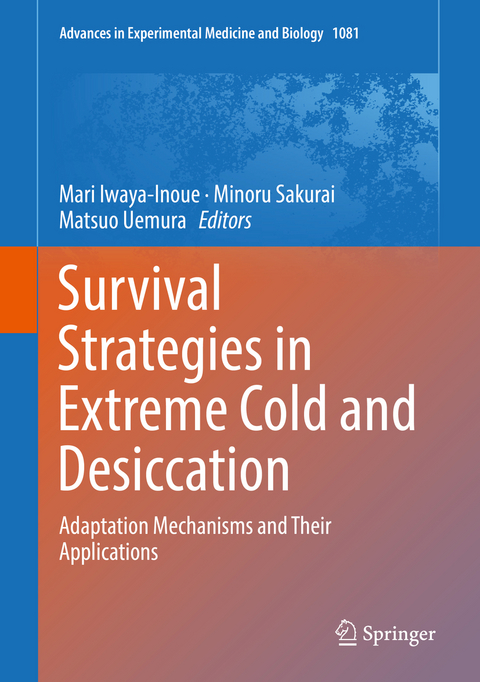
Survival Strategies in Extreme Cold and Desiccation
Springer Verlag, Singapore
978-981-13-1243-4 (ISBN)
The volume consists of three parts: Part 1, Adaptation Mechanisms of Cold, and Part 2, Adaptation Mechanisms of Desiccation, collect up-to-date research on mechanisms and strategies of living organisms such as sleeping chironomids, polar marine fishes, hibernating mammals, bryophytes, dormant seeds, and boreal plants to survive under extreme cold and desiccated conditions at molecular, cellular, and organ levels. Part 3, Application Technologies from Laboratory to Society, covers various applications to a wide variety of industries such as the medical, food, and agricultural and life science industries. For example, biological knowledge of how plants and animalssurvive under cold, drought, and desiccated conditions may provide a hint on how we can improve crop production in a very fragile environment in global climate change. Unique molecules that protect cells during desiccation and freezing such as trehalose and antifreeze protein (AFP) have potential for use to preserve cells, tissues, and organs for the long term under very stable conditions. In addition, the current progress of supercooling technology of cells may lead us to solve problems of cellular high sensitivity to freezing injury, which will dramatically improve the usability of these cells. Furthermore, knowledge of water substitution and glass formation as major mechanisms for formulation designs and new drying technologies will contribute to the development of food preservation and drug delivery systems under dry conditions. Written by contributors who have been conducting cutting-edge science in related fields, this title is recommended to a wide variety of readers who are interested in learning from such organisms their strategies, mechanisms, and applications, and it will inspire researchers in various disciplines.
Mari Iwaya-Inoue is currently a professor emerita of Kyushu University, Fukuoka, Japan, since 2017 and is also the auditor of the Japan International Research Center for Agricultural Sciences (JIRCAS), Tsukuba, since 2015. Dr. Iwaya-Inoue has been a professor, Faculty of Agriculture, Kyushu University (2004–2017) and also was appointed as vice dean of the Faculty of Agriculture (2013–2015) and vice president (Student Affairs, Promotion of Gender Equality) of Kyushu University (2014–2017). She is a regular contributor to the Japanese Society of Cryobiology and Cryotechnology and the Japanese Society of Crop Science, and she has been a member of the Japanese Society of Plant Physiologists and the Botanical Society of Japan, among others. Her research interest is plant–water relations, especially the effects of environmental stresses on physical states of water and nutrient accumulation mechanisms in crop seeds. Minoru Sakurai has been a professor at Tokyo Institute of Technology (Center for Biological Resources and Informatics) since 2003. Dr. Sakurai is a regular contributor to the Japanese Society of Cryobiology and Cryotechnology and is a member of the Biophysical Society of Japan, the Protein Science Society of Japan, the Chemical Society of Japan, and the American Chemical Society. His current research interests are experimental and theoretical elucidation of the mechanism of anhydrobiosis (life without water), and atomic-level elucidation of the functional mechanisms of ABC transporters based on first-principles computer simulations. Matsuo Uemura is currently a professor in the Department of Plant–Biosciences, Iwate University (Morioka, Japan). Dr. Uemura has been a vice president (International Liaison and Public Relations) of Iwate University since 2014 as well as visiting professor in the Department of Plant Sciences at the University of Saskatchewan (Saskatoon, Canada) since 2012. He is a member of the Japanese Society of Cryobiology and Cryotechnology, the Society for Cryobiology, the Japanese Society of Plant Physiologists, the Botanical Society of Japan, and the American Society of Plant Biologists, among other organizations. His research interests include membrane participation in plant cold acclimation and freezing injury and the molecular and physiological aspects of adaptation processes to low temperatures in plants.
Part 1. Adaptation Mechanisms for Cold.Gene Regulatory Networks Mediating Cold Acclimation: the CBF Pathway.- RNA Regulation in Plant Cold Stress Response.- The Mechanism Enabling Hibernation in Mammals.- Freezing Tolerance of Plant Cells: from the Aspect of Plasma Membrane and Microdomain.- Natural Variation in Freezing Tolerance and Cold AcclimationResponse in Arabidopsis thaliana and Related Species.- Ice nucleation activity in plants: the distribution, characterization and their roles in cold hardiness mechanisms.- Investigating Freezing Patterns in Plants Using Infrared Thermography.- Mechanism of Overwintering in Trees.- The Mechanism of Low-temperature Tolerance in Fish. Part 2. Adaptation Mechanisms for Desiccation. Mechanisms Underlying Freezing and Desiccation Tolerance in Bryophytes.- Regulatory Gene Networks in Drought Stress Responses and Resistance in Plants.- Mechanism of Stomatal Closure in Plants Exposed to Drought and Cold Stress.- Mechanismsof Maturation and Germination in Crop Seeds Exposed to Environmental Stresses with a Focus on Nutrients, Water Status, and Reactive Oxygen Species.- The Antioxidant System in the Anhydrobiotic Midge as an Essential, Adaptive Mechanism for Desiccation Survival.- Physicochemical Aspects of The Biological Functions of Trehalose and Group 3 LEA Proteins as Desiccation Protectants.- Part 3. Application Technologies from Laboratory to Society. Supercooling-Promoting (Anti-Ice Nucleation) Substances.- Applications of Antifreeze Proteins: Practical Use of the Quality Products from Japanese Fishes.- Development and Application of Cryoprotectants.- Cryopreservation of Plant Genetic Resources.- Application of protein and cell stabilization for pharmaceuticals.- Control of Physical Changes in Food Products.
| Erscheinungsdatum | 19.10.2018 |
|---|---|
| Reihe/Serie | Advances in Experimental Medicine and Biology ; 1081 |
| Zusatzinfo | 66 Illustrations, color; 35 Illustrations, black and white; X, 409 p. 101 illus., 66 illus. in color. |
| Verlagsort | Singapore |
| Sprache | englisch |
| Maße | 178 x 254 mm |
| Themenwelt | Medizin / Pharmazie ► Physiotherapie / Ergotherapie ► Orthopädie |
| Naturwissenschaften ► Biologie ► Botanik | |
| Naturwissenschaften ► Biologie ► Mikrobiologie / Immunologie | |
| Naturwissenschaften ► Biologie ► Zellbiologie | |
| Technik ► Medizintechnik | |
| ISBN-10 | 981-13-1243-5 / 9811312435 |
| ISBN-13 | 978-981-13-1243-4 / 9789811312434 |
| Zustand | Neuware |
| Haben Sie eine Frage zum Produkt? |
aus dem Bereich


